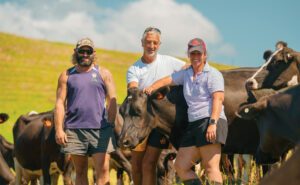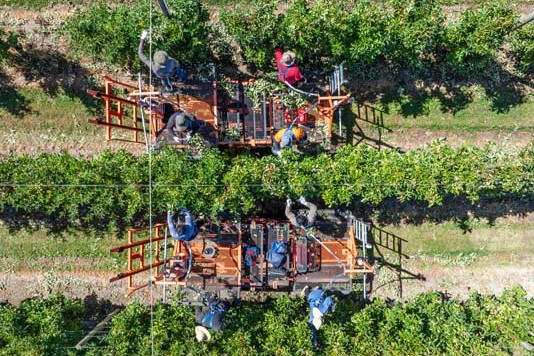Tech lets farmers get closer to the cows
Judging when a cow is on heat and whether she is at the optimum point for artificial insemination is a lot easier these days with the help of technology relaying information from an ear tag, collar or even a bolus in the rumen. By Anne Hardie.

It is possible to know the exact hour a cow comes on heat so farmers can time AI to achieve optimal results. They can buy sexed semen with more confidence of success because they know exactly when to inseminate a cow and they can pick up those cows with silent heats or those with problems that need to be resolved before they can get in-calf.
Dairy farmers using various technology talk of lower empty rates, higher six-week in-calf rates, more replacements and saleable stock, and less bobby wastage.
Senztag’s CowManager monitoring system uses ear tag technology which gathers information through its ear sensor on fertility as well as health and nutrition. For mating, it has a 98% accuracy for predicting a cow’s heat, based on information it collects from the cow such as its level of activity and ruminations.
About 250 farmers around the country now use the ear tag technology which has had algorithms developed for New Zealand’s different environments including South Island versus the North Island to better use the information.
General manager, Jared Bekhuis, says a big plus for the technology is the live repeaters that send information to a smartphone or device 24/7. That means farmers can see a cow in the early stages of heat in the morning and plan ahead for the best time to inseminate her.
He says farmers using CowManager in NZ have averaged an 8% increase in their six-week in-calf rate and a 5% decrease in their empty rate. Most of those farmers no longer use bulls, are breeding more replacements to keep or sell, often via sexed semen, and putting fewer or no bobbies on the truck. On average, the ear tag technology is costing farmers about $36/ cow/year.
Kaylene and Bill Aubrey have been using CowManager technology for the past four matings on their 300-cow herd near Tirau in the Waikato. They have recently bought another property to milk another 230 cows and factored the cost of the technology into the purchase because they want to use it for those cows as well.

Kaylene is also an artificial breeding (AB) technician and says they looked at other technology several years ago before settling on the ear tags because they were unobtrusive for the cows which were already used to wearing ear tags.
The empty rate in their three-year-old cows was 2% this year and the rest of the herd has been between 6% and 9% for the past two seasons. At this season’s mating they used sexed semen for more replacements, then used dairy beef semen including Charolais followed by shorter-gestation Belgian Blue so that they had no bulls. Instead of bobbies, they had sought-after beef breeds to sell.
For the sexed semen, she says it is so important to get the timing right and the technology gives them continuous updates so they know exactly how many hours a cow is on heat so they can inseminate exactly when they want.
“It’s all about optimising the straws you have by getting the timing right and the right cows.”
It also gives them information such as when the cow last cycled, how strong the heat is and a pattern of irregular cycles that may highlight ovarian problems.
Kaylene says the technology is displayed via graphs and colours which makes it quick and easy to understand what is happening out in the paddock. Cows coming into heat show up as light blue, moving to a light green as the heat progresses and finally dark green when they are fully on heat and ready to inseminate.
“It’s really good for heifers which sometimes only display heat characteristics for a few hours and those that are shy or don’t want to be dominated. We wouldn’t be without it and have a lot of people come and look at the system.”
The farm is not entirely flat so they now have six repeaters spread around the paddocks to capture information from cows in every corner and hollow. Each repeater costs just under $1000 each but it is a one-off cost and they all talk to each other to relay information back to the computer at the dairy.
As technology pinpoints the optimum time to inseminate cows, Kaylene says the challenge now is having enough AB technicians to visit farms more regularly to get those cows at the right time and thereby improve mating results across the industry.
If ear tag technology is not your thing, a bolus in the rumen may be the answer. SmaXtec produces boluses to administer down the throat of the cow into the reticulum where it measures core body temperature, muscle activity in the rumen and also the animal’s activity. It has been available in NZ for three years and about 100 farmers are now using the boluses in their herds to monitor cow health and improve reproduction.
SmaXtec project manager Neil Gladden says the cost of putting boluses down the throat for a 400-cow herd is about $60,000. The boluses have a battery life of four to five years and if cows are culled to the works before then, the boluses can be retrieved and put into another cow. Collars are more widely recognised and there’s several choices now available including the homegrown technology, Halter, a GPS-enabled, solar-powered smart collar fitted to the cow and coupled with a simple app. The technology enables farmers to not only detect a cow’s heat, but also remotely shift cows by using sound and vibrations to guide them around the farm.
The company kicked off on Waikato farms two years ago and is steadily getting collars on more cows throughout the country. Business manager Steve Crowhurst says the solar panels have been designed to withstand the rigours of being on a cow traipsing around a farm and provide the collar’s own power source for collecting data.
Halter’s ability to remotely guide cows and set up virtual fences takes farming to another level. Vibrations and sounds to each ear guide the cow and Crowhurst says the cows cooperate because it is a consistent set of cues to move them around the farm. Cows learn to walk forward to vibrations and sounds provide a warning when they are nearing a virtual fence.
For mating, it means farmers can bring cows out of the paddock and to the yard for insemination when the timing is right with their heat, rather than draft them out of the herd at milking and leave them on the concrete. That saves time which can be spent on other things and cows can be guided to a paddock by the yard to graze while they wait for the technician. He says it should also make it easier for technicians to get around farms at different times of the day to inseminate cows that can be remotely drafted from the paddock, rather than the pressure of getting to cows standing in the yard after milkings.
While the ability to monitor a cow’s heat is important for mating and being able to remotely draft them out of the paddock is handy, he says it is the ability to differentially manage a herd of cows to set them up well for mating that really makes the difference. Instead of one or even two mobs, farmers can split the herd into three mobs with virtual fencing and feed each mob accordingly to tighten the herd’s body-condition-score spread.
“Then you see better mating results because farmers are managing their stock better upstream.”
Pete and Ann Morgan’s Waikato herd has been through one mating with the Halter collars and learnt more about each cow than they had ever known before. Rather than farming from a computer or phone, Pete says he has got to know the cows and the farm better.
“What I love is the insights into the secret life of the cow,” he says. “The irony of it is I’ve never been closer to the farm or more importantly, closer to the cows.”
Though it is still too early to have the final results for this season’s mating, he says the empty rate has dropped a few percent and much of that can be attributed to the ability to manage grazing better with virtual fences.
From autumn last year, virtual grazing information translated into virtual break fences that allocated pasture to each animal and the result was the body condition score across the herd was more even. He says that led to better mating results. It takes about 30 seconds to create a virtual break fence on the phone which means they can give the herd a smaller area at the beginning and easily shift it out further to ensure every cow and not just the dominant girls get their allocated feed.
In the past, the Morgans headed into mating by identifying the five-week pre-mating heat and monitored the cows from that. It was simply best practice and problems were discovered early and dealt with before mating. But it was also a lot of work, Pete says.
This season was different. They could monitor every heat for each cow from calving right through to mating. It gave them a complete picture of heat frequency and the strength of the heat for each cow which meant they were “super organised” going into mating. By then they had accurately identified any cows with problems and solved them, usually through intervention.
Once mating arrived, they had a list of cows on heat to bring to the shed each morning with the timing right down to the hour and they had all their historical heats to view. They didn’t have to worry about false positives and they picked up the quiet heats in the younger, less confident cows.
It has also removed the busy period around milking when they usually draft cows on heat that will be inseminated that day.
“Our milking is busy enough to draft them, so let’s bring them in just in time for the technician.”
They have six people on the farm using the technology on their smartphones and Pete says it is a good, simple tool to use. For mating, it has given the team consistency on heat detection that was hard to achieve from a range of people judging animal behaviour. Plus, the technology has motivated staff.
“Staff truly understand all the vagaries of reproduction in the cows. Their enthusiasm is so much higher.”
They lease the collars at $16 each per month which gives them heat detection, health and drafting ability. Pete hasn’t got a solid figure, but says they are getting a good return on their investment. He acknowledges it will be some years and a range of milk payouts to prove the technology stands up functionally and economically. But he’s pretty happy with the results.






